Taxila, Pakistan
Taxila (Urdu: ٹيکسلا), is a city in Rawalpindi District of the Punjab, Pakistan. Taxila is situated about 32 km (20 mi) north-west of Islamabad and Rawalpindi, along the historic Grand Trunk Road, near the important Sikh pilgrimage centre of Hasan Abdal, and the Mughal-era Wah Gardens.
Taxila ٹيکسلا | |
|---|---|
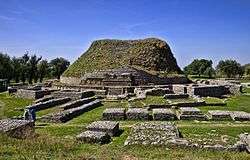 View of Taxila's Dharmarajika stupa | |
 Taxila Location in Pakistan  Taxila Taxila (Pakistan) | |
| Coordinates: 33°44′45″N 72°47′15″E | |
| Country | |
| Province | |
| Elevation | 549 m (1,801 ft) |
| Population (1998) | |
| • Total | 48,904[1] |
| Population of Taxila Tehsil: 371,140 [1] | |
| Demonym(s) | Taxilan |
| Time zone | UTC+5 (PKT) |
| Postal code | 47080 |
| Dialing code | 596 |
Ancient Taxila was historically referred to as Takshashila in Sanskrit, and Takkasila in Pali. The earliest settlement at Taxila was founded around 1000 BCE at the Hathial site.[2] The Hindu epic poem Mahābhārata is believed to have been first recited at Taxila, by the sage Vaiśampāyana.[3][4] By some accounts, Taxila was home to one of the earliest, if not the first, universities in the world.[5][6][7][8][9]
Taxila's ruins are internationally renowned, and function as a series of interrelated sites, including: a mesolithic cave, the remains of 4 ancient cities, and Buddhist monasteries and stupas.[10] The ancient ruins of Taxila were declared a UNESCO World Heritage Site in 1980.[11]
Etymology
Taxila was in ancient times known in Pali as Takkasila,[12] and in Sanskrit as Takshashila (IAST: Takṣaśilā). The city's Sanskrit name means "City of Cut Stone". The city's ancient Sanskrit name alternately means "Rock of Taksha" – in reference to the Ramayana story that states the city was founded by Bharata, younger brother of the central Hindu deity Rama, and named in honour of Bharata's son, Taksha.[13]
The city's modern name, however, is derived from the ancient Greek recording of the ancient city's name,[13][14] noted in Ptolemy’s Geography.[15] The Greek transcription of Taxila became universally favoured over time, while the Pali and Sanskrit versions fell out of use.
History
Early settlement
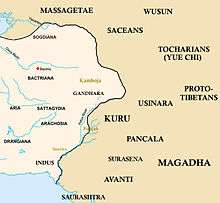
The region around Taxila was settled by the neolithic era, with some ruins at Taxila dating to 3360 BCE.[16] Ruins dating from the Early Harappan period around 2900 BCE have also been discovered in the Taxila area,[16] though the area was eventually abandoned after the collapse of the Indus Valley Civilisation.
The first major settlement at Taxila was established around 1000 BCE.[2][17][18][19] By 900 BCE, the city was already involved in regional commerce, as discovered pottery shards reveal trading ties between the city and Puṣkalāvatī.[20]
Taxila was founded in a strategic location along the ancient "Royal Highway" that connected the capital at Pataliputra in Bihar, with ancient Peshawar, Puṣkalāvatī, and onwards towards Central Asia via Kashmir, Bactria, and Kāpiśa.[21] Taxila thus changed hands many times over the centuries, with many empires vying for its control.
Achaemenid
Archaeological excavations show that the city may have grown significantly during the rule of the Persian Achaemenid Empire in the 6th century BCE. In 516 BCE, Darius I embarked on a campaign to conquer Central Asia, Ariana and Bactria, before marching onto what is now Afghanistan and northern Pakistan. Emperor Darius spent the winter of 516–515 BCE in the Gandhara region surrounding Taxila, and prepared to conquer the Indus Valley, which he did in 515 BCE,[22] after which he appointed Scylax of Caryanda to explore the Indian Ocean from the mouth of the Indus to the Suez. Darius then returned to Persia via the Bolan Pass. The region continued under Achaemenid suzerainty under the reign of Xerxes I, and continued under Achaemenid rule for over a century.[23]
Hellenistic and Mauryan
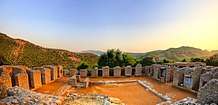
Alexander the Great invaded Taxila in 326 BCE, after the city was surrendered by its ruler, king Omphis.[23] Greek historians accompanying Alexander described Taxila as “wealthy, prosperous, and well governed.”[23] His troops were said to have found a university in Taxila, the like of which had not been seen in Greece.
After Alexander's departure, Taxila came under the influence of Chandragupta Maurya, who turned Taxila into a regional capital. His advisor, Chanakya, was said to have taught at Taxila's university.[24] Under the reign of Ashoka, the city was made a great seat of Buddhist learning, though the city was home to a minor rebellion during this time.[25]
Indo-Greek
In the 2nd century BCE, Taxila was annexed by the Indo-Greek kingdom of Bactria. Indo-Greeks build new capital, Sirkap, on the opposite bank of the river from Taxila.[26] During this new period of Bactrian Greek rule, several dynasties (like Antialcidas) likely ruled from the city as their capital. During lulls in Greek rule, the city managed profitably on its own, to independently control several local trade guilds, who also minted most of the city's autonomous coinage. In about the 1st century BCE or 1st century CE, an Indo-Scythian king named Azilises had three mints, one of which was at Taxila, and struck coins with obverse legends in Greek and Kharoṣṭhī. The last Greek king of Taxila was overthrown by the Indo-Scythian chief Maues around 90 BCE.[27] Gondophares, founder of the Indo-Parthian Kingdom, conquered Taxila around 20 BCE, and made Taxila his capital.[28] According to early Christian legend, Thomas the Apostle visits king Gondophares IV around 46 CE,[29][30] possibly at Taxila given that that city was Gondophares' capital city.
Kushan
In the first century CE, the Greek Neopythagorean philosopher Apollonius of Tyana visited Taxila, which his team described as a fortified city laid out on a symmetrical plan, similar in size to Nineveh. Inscriptions dating to 76 CE demonstrate that the city had come under Kushan rule by this time, after the city was captured from the Parthians by Kujula Kadphises, founder of the Kushan Empire.[31] The great Kushan ruler Kanishka later founded Sirsukh, the most recent of the ancient settlement at Taxila.
Decline
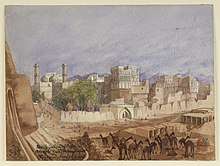
By the 300s CE, the Sasanian king Shapur II seems to have conquered Taxila, as evidenced by the numerous Sasanian copper coins found there. Taxila's ancient university remained in existence during the travels of Chinese pilgrim Faxian, who visited Taxila around 400 CE.[32] He wrote that ancient Taxila's name translated as "the Severed Head", and was the site of a story in the life of Buddha "where he gave his head to a man".[33]
The White Huns swept over Gandhāra and Punjab around 470 CE, causing widespread devastation and destruction of Taxila's famous Buddhist monasteries and stupas, a blow from which the city would never recover.[34] Xuanzang visited Taxila in 630 and 643 CE, and wrote that the city had already fallen into ruin by the time of his arrival.
Modern
The renowned archaeologist Sir Alexander Cunningham rediscovered the ruins of Taxila in the mid-19th century by identifying a local site known as Sarai kala (or Sarai Khola) with ancient Taxila. Prior to that, the location of the ancient city of Taxila, known from literary texts, was uncertain.
Geography
Taxila is located 32 km (20 mi) north-west of the Pakistani capital Islamabad. The city is located approximately 549 metres (1,801 ft) above sea level.
Climate
Taxila features a humid subtropical climate (Köppen: Cwa)[35]
| Climate data for Taxila | |||||||||||||
|---|---|---|---|---|---|---|---|---|---|---|---|---|---|
| Month | Jan | Feb | Mar | Apr | May | Jun | Jul | Aug | Sep | Oct | Nov | Dec | Year |
| Average high °C (°F) | 17 (63) |
19.5 (67.1) |
24.2 (75.6) |
29.9 (85.8) |
35.4 (95.7) |
39.5 (103.1) |
35.8 (96.4) |
33.7 (92.7) |
33.6 (92.5) |
30.9 (87.6) |
25 (77) |
19.3 (66.7) |
28.7 (83.6) |
| Daily mean °C (°F) | 9.8 (49.6) |
12.5 (54.5) |
17.3 (63.1) |
22.6 (72.7) |
27.6 (81.7) |
32 (90) |
30.3 (86.5) |
28.6 (83.5) |
27.6 (81.7) |
22.7 (72.9) |
16.2 (61.2) |
11.3 (52.3) |
21.5 (70.8) |
| Average low °C (°F) | 2.7 (36.9) |
5.5 (41.9) |
10.4 (50.7) |
15.3 (59.5) |
19.9 (67.8) |
24.5 (76.1) |
24.8 (76.6) |
23.6 (74.5) |
21.6 (70.9) |
14.5 (58.1) |
7.5 (45.5) |
3.3 (37.9) |
14.5 (58.0) |
| Average precipitation mm (inches) | 58 (2.3) |
56 (2.2) |
68 (2.7) |
44 (1.7) |
38 (1.5) |
37 (1.5) |
237 (9.3) |
236 (9.3) |
92 (3.6) |
23 (0.9) |
16 (0.6) |
36 (1.4) |
941 (37) |
| Source: Climate-Data.org, altitude: 497m[35] | |||||||||||||
Economy
Tourism
Taxila is one of northern Pakistan's most important tourist destinations, and is home to the Taxila Museum which holds a large number of artifacts from Taxila's excavations. Though the number of foreign visitors to the site drastically declined following the start of an Islamist insurgency in Pakistan in 2007, visitor numbers began to noticeably improve by 2017,[36] after the law and order situation in the region had greatly improved following the start of the 2014 Zarb-e-Azb campaign launched by the Pakistani Army against radical Islamist militants.
In 2017, the Pakistani government announced its intention to develop Taxila into a site for Buddhist religious pilgrimage.[37] As part of the efforts, it announced that an exhibition on the Buddhist heritage of the region would be held in Thailand, and that the Thai government would assist in conservation efforts at the site.[38] Relics from Taxila were also sent to Sri Lanka for the 2017 Vesak holiday as part of an effort to showcase the region's Buddhist heritage.[39] The Pakistan Tourism Development Corporation also announced in 2017 that a tour bus service would be launched between the Taxila Museum and Islamabad.[40]
In addition to the ruins of ancient Taxila, relics of Mughal gardens and vestiges of historical Grand Trunk Road are also found in Taxila. Nicholson's Obelisk, named in honour of Brigadier John Nicholson who died in during the Sepoy Mutiny of 1857, is a monument from the British era that welcomes travelers arriving from Rawalpindi/Islamabad.
Industry
Taxila is home to Heavy Industries Taxila, a major Pakistani defence, military contractor, engineering conglomerate. The city's economy is also closely linked to the large Pakistan Ordnance Factories at nearby Wah Cantt, which employs 27,000 people. Cottage and household industries include stoneware, pottery and footwear.
Transportation
Rail
Taxila is served by the Taxila Cantonment Junction railway station. Taxila Junction is served by the Karachi–Peshawar Railway Line, and is the southern terminus of the Khunjerab Railway, which connects Taxila to the Havelian railway station. A planned extension of the railway will eventually connect Taxila to China's Southern Xinjiang Railway in Kashgar, as part of the China–Pakistan Economic Corridor.
Road
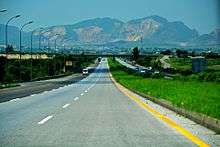
The ancient Grand Trunk Road is designated as N-5 National Highway, and connects the city to the Afghan border, and northern Punjab. The Karakoram Highway's southern terminus is in nearby Hasan Abdal, and connects Taxila to the Chinese border near theHunza Valley.
The city is linked to Peshawar and Islamabad by the M-1 Motorway, which in turn offers wider motorway access to Lahore via the M-2 Motorway, and Faisalabad via the M-4 Motorway.
Air
The nearest airport to Taxila is Islamabad International Airport located 36.5 kilometres away. Peshawar's Bacha Khan International Airport is 155 kilometres away.
Education
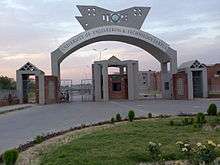
Taxila is home to many secondary educational institutes including CIIT Wah Campus, and HITEC University. The University of Engineering and Technology, Taxila was established in 1975 as a campus of the University of Engineering and Technology, Lahore, and offers bachelor, master, and doctoral degrees in engineering.
Ancient ruins
The Ruins of Taxila include four major cities, each belonging to a distinct time period, at three different sites. The earliest settlement at Taxila is found in the Hathial section, which yielded pottery shards that date from as early as the late 2nd millennium BCE to the 6th century BCE. The Bhir Mound ruins at the site date from the 6th century BCE, and are adjacent to Hathial. The ruins of Sirkap date to the 2nd century BCE, and were built by the region's Greco-Bactrian kings who ruled in the region following Alexander the Great's invasion of the region in 326 BCE. The third and most recent settlement is that of Sirsukh, which was built by rulers of the Kushan empire, who ruled from nearby Purushapura (modern Peshawar).
Culture
Modern Taxila is a mix of relatively wealthy urban, and poorer rural environs. Urban residential areas are general in the form of planned housing colonies populated by workers of the heavy mechanical complex & heavy industries, educational institutes and hospitals that are located in the area.
Museums
Taxila Museum has one of the most significant and comprehensive collections of stone Buddhist sculpture from the first to the seventh centuries in Pakistan (known as Gandharan art. The core of the collection comes from excavated sites in the Taxila Valley, particularly the excavations of Sir John Marshall. Other objects come from excavated sites elsewhere in Gandhara, from donations such as the Ram Das Collection, or from material confiscated by the police and custom authorities.
- A coin from 2nd century BCE Taxila.
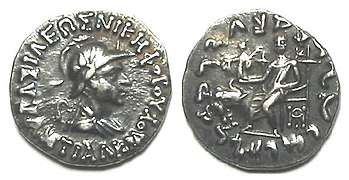 The Indo-Greek king Antialcidas ruled in Taxila around 100 BCE, according to the Heliodorus pillar inscription.
The Indo-Greek king Antialcidas ruled in Taxila around 100 BCE, according to the Heliodorus pillar inscription.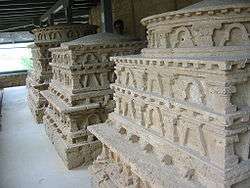 Jaulian, a World Heritage Site at Taxila.
Jaulian, a World Heritage Site at Taxila.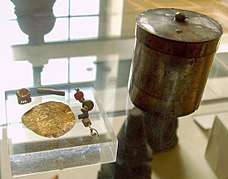 Jaulian silver Buddhist reliquary, with content. British Museum.
Jaulian silver Buddhist reliquary, with content. British Museum.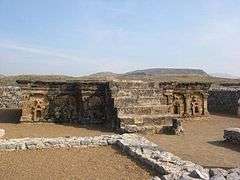 Stupa base at Sirkap, decorated with Hindu, Buddhist and Greek temple fronts.
Stupa base at Sirkap, decorated with Hindu, Buddhist and Greek temple fronts.- Stupa in Taxila.
- A Taxila coin, 200–100 BCE. British Museum.
References
- http://www.pbs.gov.pk/sites/default/files/population_census/Administrative%20Units.pdf
- Raymond Allchin, Bridget Allchin, The Rise of Civilization in India and Pakistan. Cambridge University Press, 1982 p.314 ISBN 052128550X ("The first city of Taxila at Hathial goes back at least to c. 1000 B.C.")
- Davis, Richard H. (2014). The "Bhagavad Gita": A Biography. Princeton University Press. p. 38. ISBN 9781400851973.
- Krishnan, Bal (1978). Kurukshetra: Political and Cultural History. B.R. Publishing Corporation. p. 50.
- Needham, Joseph (2004). Within the Four Seas: The Dialogue of East and West. Routledge. ISBN 0-415-36166-4.
- Kulke, Hermann; Rothermund, Dietmar (2004). A History of India (4th ed.). Routledge. ISBN 0-415-32919-1.
In the early centuries the centre of Buddhist scholarship was the University of Taxila.
- Balakrishnan Muniapan, Junaid M. Shaikh (2007), "Lessons in corporate governance from Kautilya's Arthashastra in ancient India", World Review of Entrepreneurship, Management and Sustainable Development 3 (1):
"Kautilya was also a Professor of Politics and Economics at Taxila University. Taxila University is one of the oldest known universities in the world and it was the chief learning centre in ancient India."
- Radha Kumud Mookerji (2nd ed. 1951; reprint 1989), Ancient Indian Education: Brahmanical and Buddhist (p. 478), Motilal Banarsidass Publ., ISBN 81-208-0423-6:
"Thus the various centres of learning in different parts of the country became affiliated, as it were, to the educational centre, or the central university, of Taxila which exercised a kind of intellectual suzerainty over the wide world of letters in India."
- Radha Kumud Mookerji (2nd ed. 1951; reprint 1989), Ancient Indian Education: Brahmanical and Buddhist (p. 479), Motilal Banarsidass Publ., ISBN 81-208-0423-6:
"This shows that Taxila was a seat not of elementary, but higher, education, of colleges or a university as distinguished from schools."
- "Taxila". UNESCO. Retrieved 1 June 2017.
- UNESCO World Heritage Site, 1980. Taxila: Multiple Locations. Retrieved 13 January 2007.
- Scharfe, Hartmut (2002). Handbook of Oriental Studies. BRILL. ISBN 9789004125568.
- "Taxila, ancient city, Pakistan". Encyclopædia Britannica. Retrieved 16 May 2017.
- Lahiri, Nayanjot (2015). Ashoka in Ancient India. Chapter 3: Harvard University Press. ISBN 9780674915251.CS1 maint: location (link)
- J. W. McCrindle, The Invasion of India by Alexander the Great as Described by Arrian, Q. Curtius, Diodorus, Plutarch and Justin, Westminster, Constable, 1893, pp.343–344.
- Raymond Allchin, Bridget Allchin, The Rise of Civilization in India and Pakistan. Cambridge University Press, 1982 p.127 ISBN 052128550X
- Centre, UNESCO World Heritage. "Taxila". whc.unesco.org.
- Scharfe, Hartmut (2002). Education in Ancient India. Brill Academic Publishers. p. 141. ISBN 90-04-12556-6.
- "History of Education", Encyclopædia Britannica, 2007.
- Mohan Pant, Shūji Funo, Stupa and Swastika: Historical Urban Planning Principles in Nepal's Kathmandu Valley. NUS Press, 2007 ISBN 9971693720, citing Allchin: 1980
- Thapar, Romila (1997) [1961]. Aśoka and the Decline of the Mauryas. Oxford: Oxford University Press. p. 237. ISBN 0-19-563932-4.
- "Darius the Great – 8. Travels – Livius". www.livius.org.
- Marshall, John (1975) [1951]. Taxila: Volume I. Delhi: Motilal Banarsidass. p. 83.
- Trautmann, Thomas R. (1971), Kauṭilya and the Arthaśāstra: a statistical investigation of the authorship and evolution of the text, Brill
- Thapar 1997
- Kulke and Rothermund 1998:70
- arshall 1975:84
- Marshall 1975:85
- Medlycott, A.E. (1905). "The Apostle Thomas and Gondophares the Indian King". India and the Apostle Thomas. London: David Nutt.
- Medlycott, A.E. India and the Apostle Thomas in George Menachery ed., Indian Church History Classics Vol.I, Ollur 1998.
- Kulke and Rothermund 1998:75
- Needham 2004.
- A Record of Buddhistic Kingdoms, Being an Account by the Chinese Monk Fa-Hsien of his Travels in India and Ceylon in Search of the Buddhist Books of Discipline, Chapter 11
- Marshall 1975:86
- "Climate: Taxila – Climate graph, Temperature graph, Climate table". Climate-Data.org. Retrieved 14 June 2017.
- "Tourism industry picking up as law and order situation improved". Aaj TV. 24 January 2017. Retrieved 1 June 2017.
- "PTDC to organize Buddhists' conference to promote tourism". Pakistan Today. 11 March 2017. Retrieved 1 June 2017.
- "Pakistan to organise Buddhism heritage exhibition in Thailand". Geo News. 13 March 2017. Retrieved 1 June 2017.
- "As China Pushes for a 'Buddhist' Globalisation, India Isn't Making the Most of Its Legacy". The Wire. 11 May 2017. Retrieved 1 June 2017.
- "Double decker tourist buses to be run in twin cities: PTDC". Daily Times. 2 January 2017. Retrieved 1 June 2017.
External links
| Wikimedia Commons has media related to Taxila. |
| Wikivoyage has a travel guide for Taxila, Pakistan. |
- Taxila: An Ancient Indian University by S. Srikanta Sastri
- Explore Taxila with Google Earth on Global Heritage Network
- Guide to Historic Taxila by Professor Dr. Ahmad Hasan Dani in 10 chapters
- "Taxila", by Jona Lendering
- [ Some photos by Umayr Sahlan Masud]
- Taxila page from punjab-info
- Travel With Young – Taxila 한글
- Map of Gandhara archaeological sites, from the Huntington Collection, Ohio State University (large file)
- "Taxila Museum and Jaulian Monastery", by Saadullah Bashir
- John Marshall, A guide to Taxila (1918) on Archive.org
